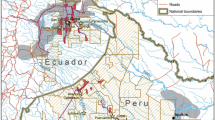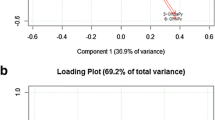Abstract
The concentrations of 1-hydroxypyrene (1-HOPYR), and 1-, 2-, 3-, and 4-hydroxyphenanthrene (HOPHE) as metabolites of pyrene and phenanthrene, were measured in urine samples collected from 124 housewives (27 smokers and 97 nonsmokers) living in Bottrop, an industrial city located in the Ruhr area in Germany. The urine samples were analyzed by a very sensitive and practical high-performance liquid chromatographic (HPLC) method using a two-column switching technique and a special precolumn packing material followed by fluorescence detection. The polycyclic aromatic hydrocarbon (PAH) metabolites are selectively enriched on the precolumn and separated from the matrix. Therefore, laborious clean-up steps were omitted. The above-mentioned PAH metabolites could be detected in all urine samples investigated. Smokers had significantly higher urine concentrations of 1-HOPYR (median 0.48 μg/g creatinine), 3-HOPHE (median 0.61 μg/g creatinine), 2-HOPHE (0.41 μg/g creatinine) and 4-HOPHE (median 0.10 μg/g creatinine) than non-smokers (median 0.15 μg/g creatinine, 0.31 μg/g creatinine, 0.31 μg/g creatinine and 0.04μg/g creatinine, respectively). The study shows that the influence of smoking is of such an order of magnitude that potential environmental exposure to PAH in this highly industrialized area is obscured by smoking habits. Furthermore, it can be concluded that the determination of 1-HOPYR, 1-, 2-, 3-, and 4-HOPHE in urine is a diagnostically useful method for the biological monitoring of persons environmentally exposed to PAH.
Similar content being viewed by others
References
Angerer J, Schaller K-H, Hausmann N (1992) Determination of 1-hydroxypyrene as a tool for biological monitoring of PAH-exposed persons. Presentation at the 13th International Symposium on PAH, Bordeaux, France
Beurteilungsmaβstäbe zur Begrenzung des Krebsrisikos durch Luftverunreinigungen. In: Abschluβbericht der Arbeitsgruppe “Krebsrisiko durch Luftverunreinigungen” des Länderausschusses für Immissionsschutz 1992
Dennis MJ (1983) Analysis of polycyclic aromatic hydrocarbons in UK total diets. Fd Chem Toxic 21:569–574
De Vos RH (1990) Polycyclic aromatic hydrocarbons in Dutch total diet samples (1984–1986). Fd Chem Toxic 28/4:263–268
Deutsche Forschungsgemeinschaft (1995) Maximum concentrations at the workplace and biological tolerance values for working materials. Report No. 31 of the Commission of the Investigation of Health Hazards of Chemical Compounds in the Work Area. VCH, Weinheim
Göen Th, Gündel J, Schaller KH, Angerer J (1995) The elimination of 1-hydroxypyrene in the urine of the general population and workers with different occupational exposures to PAH. Sci Total Environ 163:195–201
Dettbarn G, Naujack KW, Jacob J (1991) Excretion of hydroxy derivatives of polycyclic aromatic hydrocarbons of masses 178, 202, 228 and 252 in the urine of coke and road workers. Int J Environ Anal Chem 43:177–186
Grimmer G (1992) Input, monitoring and evaluation of carcinogenic environmental stress of polycyclic aromatic hydrocarbons. GIT Fachz Lab 1:12–21
Grimmer G, Dettbarn G, Jacob J (1993) Biomonitoring of polycyclic aromatic hydrocarbons in highly exposed coke plant workers by measurement of urinary phenanthrene and pyrene metabolites (phenols and dihydrodiols). Int Arch Occup Environ Health 65:189–199
International Agency for Research on Cancer (1983) Polycyclic aromatic compounds. Part 1. Chemical and environmental data, Vol 32. IARC Monographs, Lyon
— (1986) Tobacco smoking, Vol 38. IARC Monographs, Lyon
Jongeneelen FJ, Bos RP, Anzion RBM, Theuws JLG, Henderson PTH (1986) Biological monitoring of polycyclic aromatic hydrocarbons - metabolites in urine. Scan J Work Environ Health 12:137–143
Jongeneelen FJ, Anzion RBM, Henderson PTH (1987) Determination of hydroxylated metabolites of polycyclic aromatic hydrocarbons. J Chromatogr 413:227–232
Jongeneelen FJ, van Leeuwen FE, Oosterink S, Anzion RBM, van de Loop F, Bos RP, van Veen HG (1990) Ambient and biological monitoring of cokeoven workers; determinants of the internal dose of PAH. Br J Ind Med 47:454–461
Jongeneelen FJ, Anzion RBM (1991) 1-Hydroxypyrene. In: Angerer J, Schaller KH (eds) Analyses of hazardous substances in biological material, vol. 3:157–169, VCH Weinheim
Jongeneelen FJ (1994) Biological monitoring of environmental exposure to polycyclic aromatic hydrocarbons; 1-hydroxypyrene in urine of people. Toxicol Lett 72:205–211
Kanoh T, Fukuda M, Onozuka H, Kinouchi T, Ohnishi Y (1993) Urinary 1-hydroxypyrene as a marker of exposure to polycyclic aromatic hydrocarbons in environment. Environmental Research 62:230–241
Landesamt für Immissionsschutz Nordrhein-Westfalen (1992–1994) Berichte über die Luftqualität in Nordrhein-Westfalen, LIMES-Jahresbericht 1991–1993
Lintelmann J, Hellemann C, Kettrup A (1994a) Coupled-column high-performance liquid chromatographic method for the determination of four metabolites of polycyclic aromatic hydrocarbons, 1-, 4-and 9-hydroxyphenanthrene and 1-hydroxypyrene, in urine. J Chromatogr B 660:67–73
Lintelmann J, Boos K-S, Kettrup A (1994b) Biomonitoring bei PAK-Belastung mit Hilfe einer LC-LC Kopplung für die Bestimmung von 1-Hydroxypyren in Urin. BIOforum 17:442–445
Mannschreck C, Gündel J, Göen Th, Angerer J (1994) Environmental exposure to polycyclic aromatic hydrocarbons—biological monitoring of hydroxylated hydrocarbons. International symposium on human health and environment: mechanisms of toxicity and biomarkers to assess adverse effects of chemicals. 25–30.9.1994, Parma, Italy
Martin F, Hoepfner I, Scherer G, Adlkofer F, Dettbarn D, Grimmer G (1989) Urinary excretion of 2-hydroxyphenanthrenes after intake of polycyclic aromatic hydrocarbons. Environ Intern 15:41–47
Noruses MJ (1992) Statistical package for social sciences. SPSS for windows base system user's guide, SPSS Inc, Chicago
Sherson D, Sabro P, Sigsgaad T, Johansen F, Austrup H (1990) Biological monitoring of foundry workers exposed to polycyclic aromatic hydrocarbons. Br J Ind Med 47:448–453
Taussky HH (1954) A micro-colorimetric determination of creatinine in urine by the Jaffé reaction. J Biolog Chem 208:853–861
Vaessen HAMG (1988) Dietary intake of polycyclic aromatic hydrocarbons. Toxicol Environ Chem 16:281–294
Van Rooij JGM, Veegar M, Bodelier-Bade MM, Jongeneelen FJ (1994) Smoking and dietary PAH as sources of interindividual variability of urinary 1-hydroxypyrene. Int Arch Occup Environ Health 66:33–35
World Health Organization (1987) Air quality guidelines for Europe, European Series No. 23. WHO Regional Publications, Copenhagen
Author information
Authors and Affiliations
Rights and permissions
About this article
Cite this article
Gündel, J., Mannschreck, C., Büttner, K. et al. Urinary levels of 1-hydroxypyrene, 1-, 2-, 3-, and 4-hydroxyphenanthrene in females living in an industrial area of Germany. Arch. Environ. Contam. Toxicol. 31, 585–590 (1996). https://doi.org/10.1007/BF00212444
Received:
Revised:
Issue Date:
DOI: https://doi.org/10.1007/BF00212444




